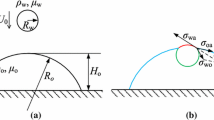Abstract.
We review here a series of experiments on the fragmentation instabilities that a liquid drop undergoes as it falls inside a fluid with which it is miscible, so called the solvent. Motivated by the original experiments initiated by Thomson and Newall in 1885, we started to investigate this subject more than one decade ago, encountering up to date a number of challenging problems in hydrodynamical instabilities, complicated by the presence of transient interfaces between the drop and the solvent. In particular, we have shown that when a drop of liquid is deposited over the surface of the same liquid, it falls down inside the solvent because the energy associated to its surface tension against air is instantaneously converted into kinetic energy. As a consequence, a very fast fluid injection takes place as the drop touches the free surface of the solvent and the drop enters inside the solvent. Due to the hydrodynamical instabilities related to the large velocity gradients, it develops into a ring that expands radially. The ring continues to go downwards inside the solvent until it stops at a certain height due to viscous dissipation. In the first stages of the ring expansion, a fluid membrane remains attached to the ring, so-called “turban" for its shape, which is concave or convex depending on the sign of the density difference between the drop and the solvent. When a small density difference is introduced between the drop and the solvent, the ring becomes unstable because of density gradients and it fragments into smaller droplets. On their turn, the secondary droplets may undergo the same instability and may fragment again, so that a cascade of fragmentation takes place. If the density difference is positive, that is, the drop is heavier than the solvent, the secondary droplets continue to go down deeper inside the solvent, until the whole process is washed out by the slow diffusion of the concentration gradients. When the density difference between the drop and the solvent is negative, then the secondary droplets rise up to the free surface of the solvent, where they are distorted by the equivalent of an impact with a rigid wall. Universal scaling laws for the cascade of fragmentation and for the dynamical behavior of the drop have been derived and accompany the experimental observations.
Similar content being viewed by others
References
J.J. Thomson, H.F. Newall, Proc. Royal Soc. 39, 447 (1885)
D.W. Thomson, On Growth and Form (Cambridge University Press, 1963)
N. Baumann, D.D.J. Joseph, P. Mohr, Y. Renardy, Phys. Fluids A 4, 567 (1992)
D.J. Korteweg, Arch. Neerl. Sci. Ex. Nat. II 6, 1 (1901)
S. Residori, E. Pampaloni, P.K. Buah-Bassuah, F.T. Arecchi, Eur. Phys. J. B 15, 331 (2000)
F.T. Arecchi, P.K. Buah-Bassuah, F. Francini, C. Perez-Garcia, F. Quercioli, Europhys. Lett. 9, 333 (1989)
F.T. Arecchi, P.K. Buah-Bassuah, C. Perez-Garcia, Europhys. Lett. 15, 429 (1991)
F.T. Arecchi, P.K. Buah-Bassuah, F. Francini, S. Residori, Phys. Rev. E 54, 424 (1996)
P.K. Buah-Bassuah, R. Rojas, S. Residori, F.T. Arecchi, Phys. Rev. E 72, 067301 (2005)
D.J. Tritton, Physical Fluid Dynamics (Oxford University Press, New York, 1988)
See e.g. D.D. Joseph, Eur. J. Mech. B/Fluids 9, 565 (1990); P. Petitjeans, T. Maxworthy, J. Fluid. Mech. 326, 37 (1996); E. Lajeunesse, J. Martin, N. Rakotomalala, D. Salin, Phys. Rev. Lett. 79, 5254 (1997)
S. Middleman, Modeling Axisymmetric Flows (Academic Press, San Diego, California, 1995)
G.H. Ristow, Phys. Rev. E 55, 2808 (1997)
A. Garcimartin, H.L. Mancini, C. Perez-Garcia, Europhys. Lett. 19, 171 (1992)
R.C. Weast, Handbook of Chemistry and Physics (The Chemical Rubber Co., Cleveland, Ohio, 1971)
O.N. Boratav, R.B. Pelz, N.J. Zabusky, Phys. Fluids A 4, 581 (1992)
H. Froechling, J.P. Crutchfield, D. Farmer, N.H. Packard, R. Shaw, Physica D 3, 605 (1981)
R.R. Prasad, C. Meneveau, K.R. Sreenivasan, Phys. Rev. Lett. 61, 76 (1988)
T.C. Hasley, M.H. Jensen, L.P. Kadanoff, I. Procaccia, B.I. Shraiman, Phy. Rev. A 33, 1141 (1986)
J. Feder, Fractals (Plenum, New York, 1988)
E. Guyon, J.-P. Hulin, L. Petit, Hydrodynamique Physique (InterÉditions, Éditions du CNRS, Paris 1991), p. 323
See e.g. J. Eggers, Rev. Mod. Phys. 69, 865 (1997)
Author information
Authors and Affiliations
Rights and permissions
About this article
Cite this article
Residori, S., Buah-Bassuah, P. & Arecchi, F. Fragmentation instabilities of a drop as it falls in a miscible fluid. Eur. Phys. J. Spec. Top. 146, 357–374 (2007). https://doi.org/10.1140/epjst/e2007-00193-8
Issue Date:
DOI: https://doi.org/10.1140/epjst/e2007-00193-8




